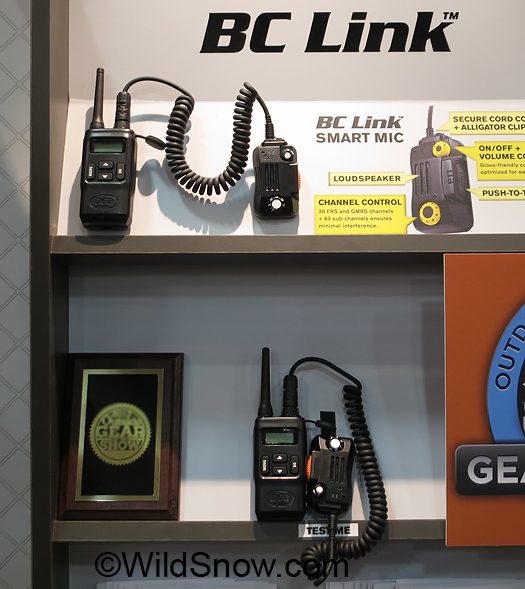Shop for BC Link ski touring radio.
While they’re sometimes as fiddly as a worn out pinball machine (and make the same noises), consumer type 2-way radios can save your bacon. Indeed, I know of at least one avalanche taken life that could have been preserved by a simple “go right” spoken on a 2-way.
Problem is, most of the consumer FRS two way radios out there are over featured and under engineered junk. Certain models can be pressed into heavy service as we did on Denali a few years ago and do so daily when we’re on backcountry skiing trips, and you can find limited offerings that are somewhat pro grade. But most are toys. (And yes, you can program FRS frequencies into a higher quality ham type unit, but while doing so works nicely, it is illegal and such radios can be expensive and over featured.)
Thus, I wasn’t surprised to see Backcountry Access, the electronics geeks who pretty much invented the digital beacon, have come out with their own version of an FRS radio specifically for backcountry snowsports.
Guiding idea of the Link is you have a small base unit that rides in your backpack or a jacket pocket. The base unit has a limited set of controls and a small LCD for changing presets and such, but no PTT button (push to talk) and no speaker or mic. Instead, the controls you use for communication are all on the speaker mic, attached to the base unit with a beefy coil cord and worn on your pack strap.
Key points about Link FRS radio:
– Provides all FRS/GMRS channels you get on most consumer FRS radios, along with quiet codes.
– Thankfully no roger beeps or call alarm tones you normally have to spend time kludging through menus to turn off, but turn themselves on if the radio setting happen to reset for some reason.
– Hand mic is splash proof, may need better water proofing if designed for 24/7 external use on backpack.
– Nominal supply voltage is 3.7. This helps keep battery size small, but will make this unit difficult to run with a basic automobile adapter (instead, you’ll need USB voltage which is inefficient due to the need for voltage step down from 12 bolt).
– Battery is lithium-ion, recharged with USB type voltage and connector. Battery pack is easily snapped off and on, thus easy to carry a spare.
– No word on if unit will run off USB power with dead battery, an important feature in my view.
– Antenna is fixed not removable, per FCC regulations for FRS radios.
– Weather receive frequencies are built-in.
– Speaker mic cord plug will not pull out by accident, unlike other brand models that require taping or otherwise securing the mic plug.
– BCA publication “Human Factors and Group Communication” is a data dump of radio tips and techniques that every backcountry recreator should read. Once you do, I think you’ll be convinced your group should all be sporting 2 ways.
Provided the Link radio is made with good quality and not too expensive, downsides are few. Main annoyance will be having a base unit that can’t be used independently. In my style of radio use, when stationary or at the base cabin or hut I like working a handheld two-way without a cord and speaker mic. I then plug in the mic when I rig for travel. With the Link unit, you’ll have to carry the cord, mic and base unit around the hut or have it cluttering up your car console. Of course for those uses you could always run a few el-cheapo blister pack FRS radios. But then, ever more junk to shlep around.
Another downside is Link appears to be a bit heavy (PR says 8 ounces) compared to consumer type FRS radios. I wouldn’t be surprised if using it will result in at least 3 or 4 more ounces of weight as compared to a small FRS combined with a basic mic. Let’s hope that’s not the case. If so, smaller and lighter consumer models will continue to fill the gap, and when cared for correctly they do work.
Thinking about all this, I wouldn’t be surprised if BCA ends up offering several models of their Link, including one with a stand-alone base unit that doesn’t require a speaker mic, and one that does. Probably my biggest gripe will be that they don’t offer an AA battery pack — an accessory that can save your behind while traveling away from easily accessed wall voltage. (Solution for that is a generic auxilary battery pack with USB port–heavy for backcountry use, but good for the hut or automobile.)
In all, we’re experiencing shakes of joy seeing the backcountry skiing industry wake up to the efficacy of 2-way radio communication. It is for everyone, not just guides and helicopter pilots.
Shop for BC Link ski touring radio.
WildSnow.com publisher emeritus and founder Lou (Louis Dawson) has a 50+ years career in climbing, backcountry skiing and ski mountaineering. He was the first person in history to ski down all 54 Colorado 14,000-foot peaks, has authored numerous books about about backcountry skiing, and has skied from the summit of Denali in Alaska, North America’s highest mountain.

